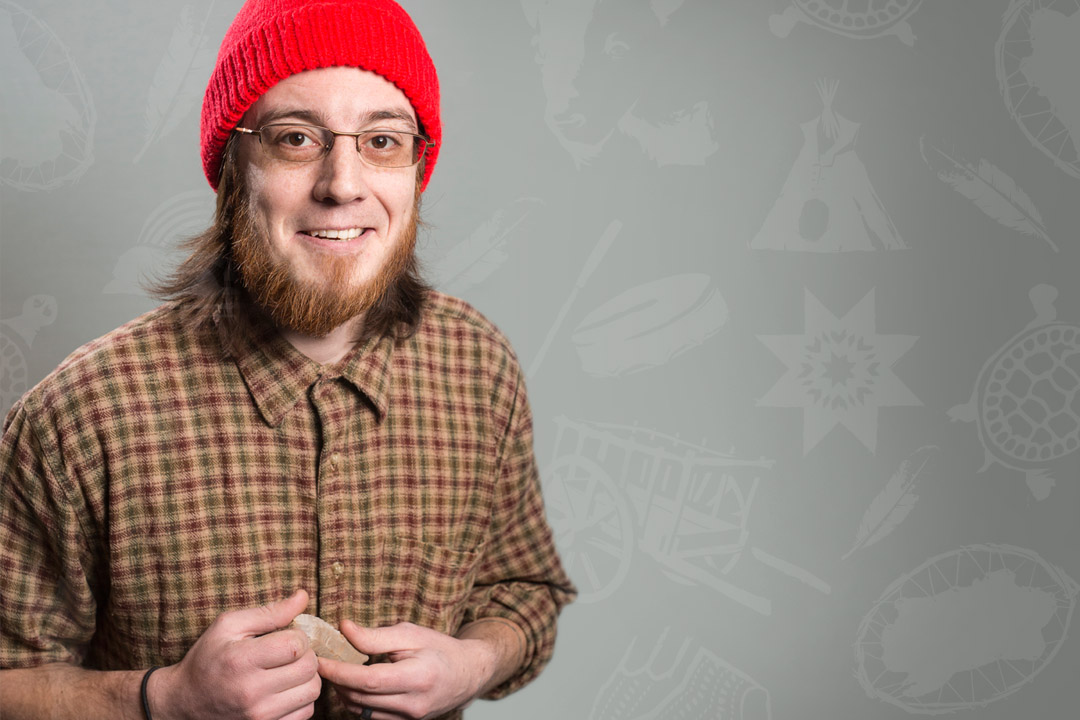
Meet the Aboriginal Student Achievement Award winners: Gabriel Lamarche
From a young age Gabriel Lamarche was interested in archaeology. Now he works to teach others about this passion.
By Jordan SherbinoThis week the University of Saskatchewan is celebrating Aboriginal Achievement Week with a range of cultural events, discussion panels, artistic activities and celebrations.
Each year, there is an awards ceremony to honour Indigenous students and to recognize their academic accomplishments, leadership, research endeavours or community volunteerism.
One of the award winners this year is Gabriel Lamarche, a third-year archeology major in the College of Arts and Science, who is getting an award for his academic achievements.
Not only is Gabriel a strong student academically, but he’s also shown tremendous leadership in archaeology with a strong willingness to be engaged in both the classroom and the community.
Gabriel is a highly accomplished—and largely self-taught—flintknapper, or maker of stone tools, who has actively shared his knowledge and expertise with other students and members of the public. He routinely gives flintknapping demonstrations in classes, leads weekly flintknapping workshops and produces replica tools for both instruction and display.
Gabriel serves on the executive of the Archaeology and Anthropology Students’ Association and has been recommended for a board position with the Saskatchewan Archeological Society.
We caught up with Gabriel to ask him a few questions about what got him interested in flintknapping and archaeology more generally.
What got you interested in archaeology?
It wasn’t one isolated event which goaded me onto this path, but one of the most pivotal moments was probably when I was about 10 or 12 and witnessed—and participated a little bit in—an archaeological mitigation project at a Camp Kitchikewana, on Beausoleil Island, in Georgian Bay Islands National Park. Here I oversaw an exchange of knowledge between a good archaeologist and a respected Midewewin elder. I recognized then that we are literally standing upon thousands of years of history, extending much farther back than written accounts, which can be carefully excavated and studied and understood, and that the elders and the archaeologists are both scholars of different aspects of the same reality: our heritage.
Archaeology can provide radiocarbon dates, chemical isotope ratios, precise measurements and many types of accurate details, while many of our elders carry very specific knowledge of cultural meanings and significance which colour and animate the ancient past. By meshing the knowledge of both realms, we can move towards a fuller understanding of our ancestors. I’m slowly coming to consider ‘good archaeologist’ as somewhat synonymous with Oshkaabewis [Ojibwe for a traditional helper or attendant of the elders], and hopefully, one day soon, vice versa will be openly recognized as well.
Why did you first get into flintknapping?
I first started trying when I was a boy. During that archaeological excavation, one of the archaeologists, a kind man from Italy, uncovered a ‘knapping work station’ where someone had sat several thousand years ago, and made some tools by fracturing stone, leaving behind some shards and chips. As he explained it to me, I realized I had no real idea what that really was, and that fascinated me. In the upper levels, wrought iron nails were found. I knew what a nail was, I knew what iron was, I could understand that. Bits of broken china and glass were found. That too, I could understand.But breaking stone to make beautiful tools? That captivated me, and I set myself to learn how.
It was very slow going. I asked some of my traditional elders to teach me, but they, having been through residential school and often born to parents who had been through residential school, just said “we don't need to do that anymore.” I was disheartened and realized that their response had more to do with their experiences of acculturation than what I needed. Though some of our ancestors may have put down a particular bundle, that doesn’t mean it should never be picked up again. I was lucky to live in an area that was fairly rich in good knappable stone so I was able to learn some of the fundamentals on my own by trial and error, but the nuances of it eluded me.
Puberty interrupted my quest to learn, (teenage girls didn't think stone tools were very ‘cool,’ so I had to become a musician for a while) but when I was about 20, I came across a book by an archaeologist and a flintknapper, D.C. Waldorf, on the topic of flintknapping. While reading it the lightbulb came on in my head and I realized the nuances I had missed as a boy, and this set me on a renewed course. Since then, I've spent most free hours practicing and refining my techniques, learning to use the tools, applying them to other crafts and researching related topics.
What is your favourite thing that you’ve ever made via flintknapping?
I don’t really have one favourite thing—each new project brings new challenges and new joys. I enjoy attempting the bold flint daggers from chalcolithic Northern Europe, and it’s meditative to practice carefully peeling little razors from paleolithic Siberian microblade cores. I guess my favourite would be attempting to replicate paleolithic spear points from this continent—many of those old ones are masterpieces of both artistry and function, elegant in form but rigorous in execution.
I’ve recently started experimenting with the styles of Mayan ceremonial pieces, but I practice the flaking techniques only, without imitating the physical motifs, because those obviously have significance which I haven’t received appropriate teachings on, so I’ll apply the techniques, for example, to make a broad knife form while hollowing out the inside, together forming a letter. I love exploring the landscapes of the craft, the peaks from the places and times when people truly dedicated themselves to stone, not merely for utility, but also for cultural and personal expression.
To learn more about the events that are taking place this week, be sure to check out the Aboriginal Achievement Week website.

